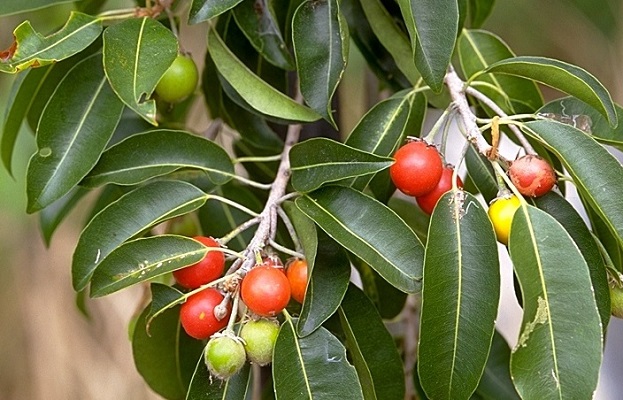On This Page
Salmali–Salmalia malabarica
Introduction
Salmali, commonly known as silk cotton tree is one of the most readily available herbs in India. Salmali bears beautiful red flowers which stops diarrhoea and hence given the name. The species name malabarica indicates that the plant is native to Kerala. The fruit of the plant have cotton like substance and hence also known as Thulaphala.
Institute of Applied food Allergyguided by Dr.Gupta,has been consistently working on the plant Salmalifor acquiringknowledge about more medicinal properties. Our experts found out that the plant can act as an antiallergic, anti-inflammatory, antimicrobial, astringent, diuretic , styptic,tonic, and antipyretic agent. Itcan be also used for conditions like Diarrhea,burning sensation , Cough, Inflammation, Diabetes, Piles, Obesity etc. The methanol extract of the plant have anti-inflammatory effects. It can also be used for the management of hyperglycemia and hyperlipidemia as it contains hexane fractions. The aqueous and crude ethanolic extracts of the plant have diuretic effects.
Action of BilvaSalmali – Salmalia malabaricain Allergies
IAFA has been conducting various studies on Salmali to found out the antiallergic andanti-inflammatory properties of the plant. The plant contains phytoconstituents like Naphthaquinone, B sitosterol ,lupeol, glucoside, hentriacontane, hentriacontanol, essential oil, kaempferol, quercitin, palmitic acid etc and these aids in the antiallergic action of the herb. The Decoction prepared from the bark of Salmali is helpful to alleviate skin allergic conditions.
Vernacular Names
| Sanskrit Name | Salmali,Thulaphala ,Nurma |
| Hindi Name | Nurma |
| English Name | Silk cotton tree |
| Malayalam Name | Mullulavamarum |
| Kannada Name | Kempuboorugada |
| Marathi Name | Tambadi savaru |
Botanical Name
Salmaliamalabarica
Family
Bombaceae
Morphology of Salmali – Salmalia malabarica
- A tall tree
- Trunk is prickly when young
- Leaves are compound, lanceolate
- Flowers are dirty white
- Fruits are capsule
Ayurveda reference of Salmali – Salmalia malabarica

Geographical distribution of Salmali – Salmalia malabarica
Salmali found throughout India especially in forest and hilly areas.
Phytoconstituents of Salmali – Salmalia malabarica
Naphthaquinone, B sitosterol ,lupeol, glucoside, hentriacontane, hentriacontanol, essential oil, kaempferol, quercitin, palmitic acid.
Parts used of Salmali – Salmalia malabarica
- Exudate(Niryasa)
Dosage of Salmali – Salmalia malabarica
- Exudate (Niryasa) -1-3 g
- Powder (churna)- 5 g
- juice(swarasa)-10 ml
Medicinal Properties of Salmali – Salmalia malabarica
- Daha hara – relieves burning sensation
- Vrishya-aphrodisiac
- Grahi-Constipative
- Sulahara-relieves pain
- Sophahara – relieves swelling
- Swasahara – relieves asthma
- Kushtaghna-alleviateskindisorders
- Krimighna – useful in worm infestations
- Vranahara – useful in wounds

Have A Health Issue?
Consult Online
- Dr. Sahil Gupta (B.A.M.S., M.H.A.)
Ayurvedic Allergy Specialist
CEO & Founder of IAFA®
Home remedies of Salmali – Salmalia malabarica
Ayurveda is a devine medicinal system present from ancient times. The medicines used in Ayurvedic treatmentsare naturally available herbs which are toxic free and readily available. Salmali is one among the common herbs used in Ayurveda treatment procedure. Due to its high medicinal value it is used in treating many diseases like,
- In Gastro enteritis(Pravahika)-Enema of leaf petiole of Salmali is boiled with milk and then mixed with ghee. It is taken internally
- In Freckles (Vyanga) – Powder prepared from sharp thorns of Salmali triturated with milk and applied over face.
- In haemorrhage (Raktapitta) –Milk processed with exudate of Salmali is useful in haemorrhage
- In Diabetes (Prameha) – Powder of Salmaliroot is taken along with Gooseberry and honey at a dose of 5g daily will check diabetic condition.
- As a carminative (Deepana) – Salmali fruit ispowdered and istakenorally before food. It can act as a carminative.
- As an analgesic (Sulaghna) –Decoction made of the leaves of Salmali will relieve pain.
- In Fever (Jwara) – Decoction made with leaves of Salmali and Tulsi taken internally at a dose of 60 ml.
- In Inflammation (Sopha) – Paste prepared from Salmali and ghee is applied over the skin part.
Dr.Gupta’s IAFA,for the past few year are consistently working on different plants to find out their medicinal properties. Weselects naturally available non toxic herbs for treatment purposes that are mentioned in ancient Ayurvedic textbooks. Our treatments and medicines are 100% risk free and are prepared by following strict guidelines. We follows textbooks like Susrutha Samhitha for the purpose of treatment protocols.
Reach IAFA for safe herbal remedies for all your ailments!!!
Was this Page Helpful?
Read More Articles

Kasini (Cichorium intybus)
Know about the uses, benefits, and medicinal properties of Chicory, Kasini (Cichorium…








